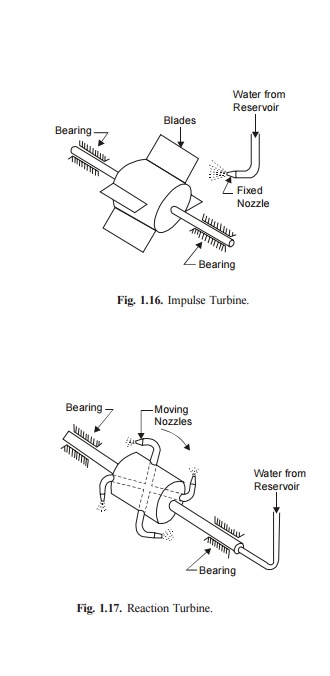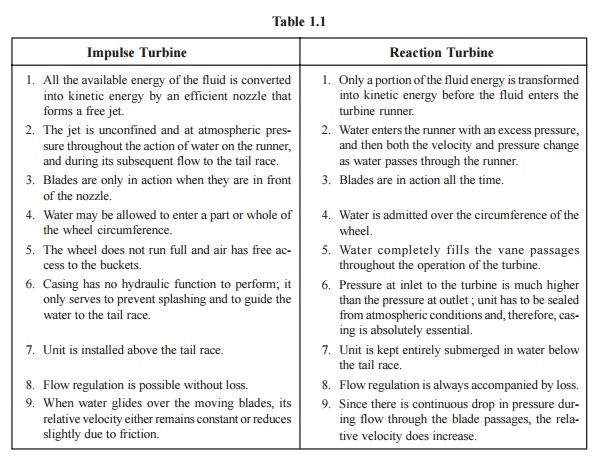Chapter: Power Plant Engineering Fundamental
Difference between Impulse and Reaction Turbine

MPULSE AND REACTION TURBINES
Hydraulic turbines are
required to transform fluid energy into usable mechanical energy as
effi-ciently as possible. Further depending on the site, the available fluid
energy may vary in its quantum of potential
and kinetic energy. Accordingly a suitable type of turbine needs to be selected
to perform the required job.
Based upon the basic
operating principle, water turbines are categorized into impulse and reaction
turbines depending on whether the pressure head available is fully or partially
converted into kinetic energy in the nozzle.
Impulse Turbine wherein the available
hydraulic energy is first converted into kinetic energy by means of an efficient nozzle. The high velocity jet issuing from
the nozzle then strikes a series of suitably shaped buckets fixed around the
rim of a wheel (Fig. 1.16). The buckets change the direction of jet without
changing its pressure. The resulting change in momentum sets buckets and wheel
into rotary motion and thus mechanical energy is made available at the turbine
shaft. The fluid jet leaves the runner with a reduced energy. An impulse
turbine operates under atmospheric pressure, there is no change of static
pressure across the turbine runner and the unit is often referred to as a free
jet turbine. Important impulse turbines are: Pelton wheel, Turgo-impulse wheel,
Girad turbine, Banki turbine and Jonval tur-bine etc., Pelton wheel is
predominantly used at present.
Reaction Turbine wherein a part of the total
available hydraulic energy is transformed into kinetic energy before the water is taken to the turbine runner. A
substantial part remains in the form of pressure energy. Subsequently both the
velocity and pressure change simultaneously as water glides along the turbine
runner. The flow from inlet to outlet of the turbine is under pressure and,
therefore, blades of a reaction turbine are closed passages sealed from
atmospheric conditions.

Fig. 1.17 illustrates
the working principle of a reaction turbine in which water from the reservoir
is taken to the hollow disc through a hollow shaft. The disc has four radial
openings, through tubes, which are shaped as nozzles. When the water escapes
through these tubes its pressure energy decreases and there is increase in
kinetic energy relative to the rotating disc. The resulting reaction force sets
the disc in rotation. The disc and shaft rotate in a direction opposite to the
direction of water jet. Important reaction turbines are, Fourneyron, Thomson,
Francis, Kaplan and Propellor turbines Francis and Kaplan turbines are widely
used at present.
The following table
lists salient points of difference between the impulse and reaction turbines
with regard to their operation and application.

Impulse Turbine
1.
All the available energy of the fluid is
converted into kinetic energy by an efficient nozzle that forms a free jet.
2.
The jet is unconfined and at atmospheric
pressure throughout the action of water on the runner, and during its
subsequent flow to the tail race.
3.
Blades are only in action when they are
in front of the nozzle.
4.
Water may be allowed to enter a part or
whole of the wheel circumference.
5.
The wheel does not run full and air has
free access to the buckets.
6.
Casing has no hydraulic function to
perform; it only serves to prevent splashing and to guide the water to the tail
race.
7.
Unit is installed above the tail race.
8.
Flow regulation is possible without
loss.
9.
When water glides over the moving
blades, its relative velocity either remains constant or reduces slightly due
to friction.
Reaction Turbine
1.
Only a portion of the fluid energy is
transformed into kinetic energy before the fluid enters the turbine runner.
2.
Water enters the runner with an excess
pressure, and then both the velocity and pressure change as water passes
through the runner.
3.
Blades are in action all the time.
4.
Water is admitted over the circumference
of the wheel.
5.
Water completely fills the vane passages
throughout the operation of the turbine.
6.
Pressure at inlet to the turbine is much
higher than the pressure at outlet ; unit has to be sealed from atmospheric
conditions and, therefore, casing is absolutely essential.
7.
Unit is kept entirely submerged in water
below the tail race.
8.
Flow regulation is always accompanied by
loss.
9.
Since there is continuous drop in
pressure during flow through the blade passages, the relative velocity does
increase.
Related Topics